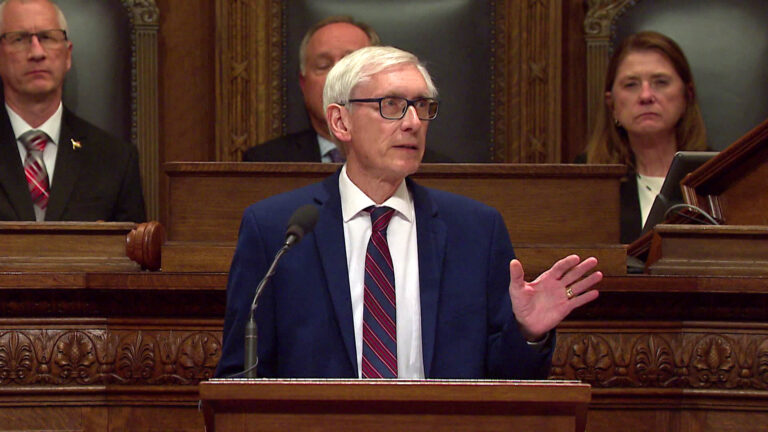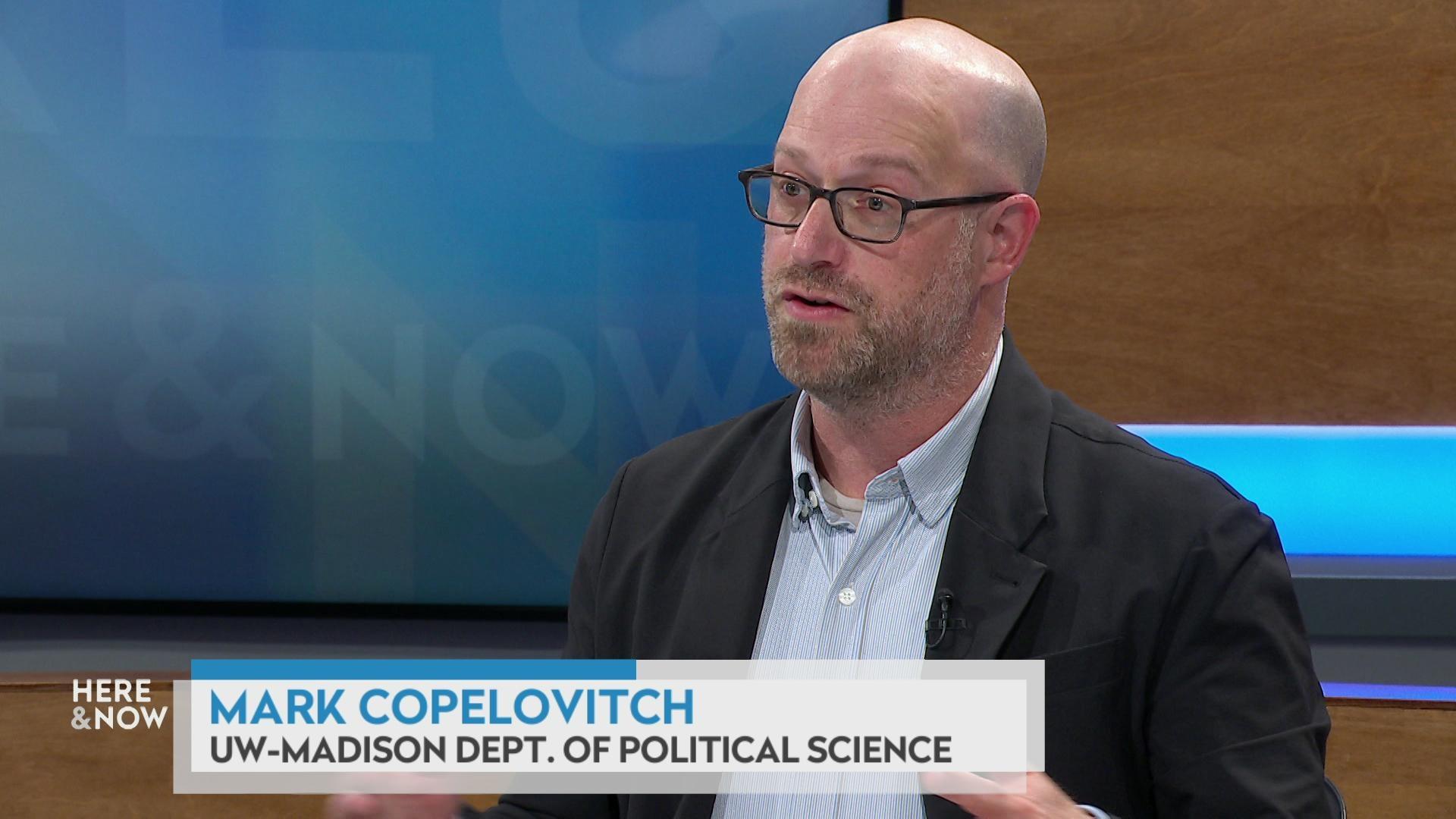Karen Timberlake:
We know that our hospitals and our hospital systems across the state are feeling the strain of this increase in disease activity. Across our state today, only about 5% of beds in our intensive care units are available, and 5% of medical surgical beds are available. And reports of pressures on staffing and staff availability are coming in from hospitals and long-term care providers all across Wisconsin.
Frederica Freyberg:
Among those recently in intensive care with COVID-19, Wisconsin State Senator Andre Jacque. He was released to an intermediate care facility this week. Also this week though she is not reporting symptoms Republican candidate for governor Rebecca Kleefisch announced she had recently tested positive for COVID. The Wisconsin Hospital Association reports 1,072 patients hospitalized for COVID-19 today, including 335 in the ICU. “Here & Now” was inside one such intensive care unit in recent days to see what the grave situation looks like from the vantage of the frontline health workers fighting the most serious of cases. Marisa Wojcik reports from Marshfield.
William Melms:
The pandemic was looking like it was essentially over two months ago. We had zero to two, maybe three patients in the hospital.
Marisa Wojcik:
William Melms is the chief medical officer for the Marshfield Clinic Health System.
William Melms:
Today, we watched the state of Wisconsin, the number of new patients continues to rise and the new patients per day are the kind of leading indicator of what we can expect. So we have grave concerns yet that we’re not near the end of this surge.
Marisa Wojcik:
During rounds in the COVID ICU, doctors, nurses and residents are busy discussing each patient’s progress and treatment plan. Patients are here for weeks, usually in a medically-induced coma as machines work to save their lives.
Ryan Letsch:
Everyone is seeing stuff in the new they don’t believe it until it’s happening to them.
Marisa Wojcik:
Ryan Letsch is a COVID ICU nurse.
Ryan Letsch:
Or they do know what’s happening and that makes them even more scared.
Marisa Wojcik:
He specializes in administering a respiratory treatment called ECMO.
Ryan Letsch:
What ECMO does is we’re allowed to have the lungs do basically nothing as we oxygenate through the machine and keep the patient’s brain and heart and kidneys all healthy with oxygen.
Marisa Wojcik:
It can be the last tool health workers have to save a patient’s life. But ECMO resources are limited and in high demand across the country as the Delta surge continues to worsen.
Vicky Varsho:
The patients are sicker this time. We see that they’re deteriorating quicker as well and being sicker requires more resources.
Marisa Wojcik:
Vicky Varsho, a chief nursing officer, says Delta in inundating health systems everywhere.
Vicky Varsho:
We’re getting calls from Canada. We’re getting calls from the east, from the west. We’re getting calls from people we’ve never received their patients from before because they are so strapped for beds and resources as well.
Marisa Wojcik:
Letsch sees the ruin this disease leaves every day, comparing it to a hurricane, leaving destruction in its wake.
Ryan Letsch:
There’s definitely a different feeling when we’re putting a breathing tube in these COVID patients just because so often we’re not able to hear from them again. And knowing that, going into the breathing tube is very, very difficult.
Marisa Wojcik:
Their stories endure and so does the trauma.
Ryan Letsch:
Having to convey or do Facetime with these patients and their family, we’re really — we’re the middleman, having to say hello to their son who’s going to college for the first time or people are getting married and watching them have to see it through a tiny camera on their phone while they’re intubated is very tough.
Marisa Wojcik:
Staffing shortages were a problem before 2020. And the pandemic has made it worse as many health care workers leave the profession.
Ryan Letsch:
Worsening burn-out turns into a vicious cycle because they leave health care, another new person replaces them and the issue isn’t fixed so they get that burn-out all over again.
Marisa Wojcik:
And the emotional toll is greater now, as the issue of the pandemic rolls on and the patients are not only sicker, they’re younger.
William Melms:
We have had pediatric cases. The youngest patient we had was four months old. The demographic of the patients we admit in our facilities are certainly younger than they were last year. Absolutely the case. Absolutely the concern.
Marisa Wojcik:
Health officials are hoping more people will choose to get vaccinated against COVID-19 in the wake of this latest surge.
Ryan Letsch:
Even some family members who were very against the vaccine, it’s a lot different when they’re crying over their spouse. Every single one of them have gotten the vaccine that day of admission or the very next day.
William Melms:
The frustrating aspect of this pandemic is that we could be preventing so much of this and we’re not.
Marisa Wojcik:
For “Here & Now,” I’m Marisa Wojcik in Marshfield.
Frederica Freyberg:
The director of the CDC this week gave the green light to Pfizer booster shots for health care workers, teachers and other frontline workers.
Search Episodes
News Stories from PBS Wisconsin

Donate to sign up. Activate and sign in to Passport. It's that easy to help PBS Wisconsin serve your community through media that educates, inspires, and entertains.
Make your membership gift today
Only for new users: Activate Passport using your code or email address
Already a member?
Look up my account
Need some help? Go to FAQ or visit PBS Passport Help
Need help accessing PBS Wisconsin anywhere?

Online Access | Platform & Device Access | Cable or Satellite Access | Over-The-Air Access
Visit Access Guide
Need help accessing PBS Wisconsin anywhere?

Visit Our
Live TV Access Guide
Online AccessPlatform & Device Access
Cable or Satellite Access
Over-The-Air Access
Visit Access Guide
 Passport
Passport


















Follow Us